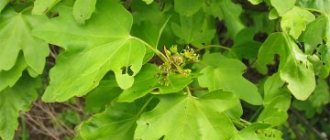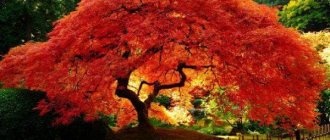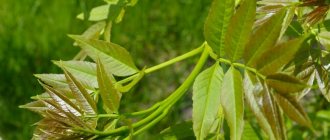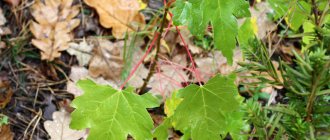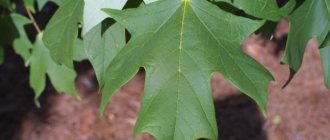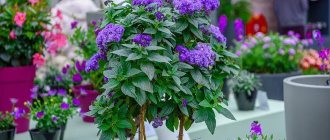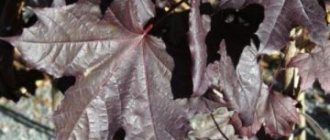The Norway maple plant has long been used for the improvement of urban buildings and personal plots due to its set of valuable qualities. The tree reproduces well and is resistant to weather vagaries. There are many decorative varieties of beautiful crops with a compact crown and unusual foliage color.
Description of Norway maple
The tree is dioecious, deciduous, and belongs to the Sapindaceae family. In central Russia and in most European countries, the crop is found everywhere along highways, present in gardens, mixed forests, and shelterbelts. The description of the Norway maple tree (sycamore, sycamore) is familiar to many due to the special shape of the carved foliage. The maximum distribution in the north is the southwestern borders of the Arkhangelsk region, where the crop grows in the form of shrubs. Under optimal conditions, the crown height reaches 28 m.
What does Norway maple look like?
The appearance of a beautiful tree is recognizable to everyone. From afar, Norway maple can be confused with sugar maple, but this also has its own nuances. The American species has clear sap, rougher and rougher bark, and autumn foliage that is bright orange and more triangular. Let's look at the characteristic features of our European platanolea maple:
- Milky juice.
- The bark is relatively smooth, gray-brown in color, with narrow cracks.
- Foliage up to 18 cm long, wide, serrated blades, up to 5-7 blades.
- Norway maple flowers are yellowish-green in color with a fragrant aroma, growing in 15-30 pieces. in bunches.
- In spring, the leaves are pale green or dark green; by autumn, the blades turn yellow or orange.
- The branches are reddish-gray or brown.
- Norway maple produces fruits in the form of a double lionfish up to 5.5 cm long.
- The seeds are bare with a thin skin.
- Seeds ripen in September.
- Fruiting from the age of 17.
- Durability up to 150 years.
Community of little green men
Acer, Maple. Trees and shrubs with opposite buds and simple, usually palmate or entire or pinnately compound leaves without stipules. Flowers are bisexual or unisexual (due to underdevelopment of the pistil or stamens). The fruits are lionfish with an elongated wing. Flowers in panicles or corymbs.
Etymology
The name is derived from the Latin acer - “sharp”, from the shape of the leaves with sharp blades.
Types and varieties of maple
The genus contains about 150 species, distributed in North America, Asia, Europe and North Africa, mainly in areas with temperate climates. There are 16 species growing in our country. About 40 species are used in ornamental gardening.
Types and varieties of maples
Norway maple, or sycamore maple (Acer platanoides)
Homeland - European Russia and the Caucasus.
Norway maple reaches a height of 30 m, the bark is fissured, at first dark gray, later turning black. It blooms in mid-May, at the same time as foliage.
The species is demanding on soils, does not tolerate stagnant moisture and salinity, and is wind-resistant.
USDA Zone 3 (4)
Norway maple, or sycamore maple, Acer platanoides
Decorative forms and varieties of Norway maple:
'Albescens' is a large deciduous tree with a broad oval crown, young leaves are creamy white, mature leaves are green;
'Bicolor' - young leaves are light yellow with cream strokes, later they turn pink;
‘Cleveland
' - characterized by a compact crown shape, when blooming the leaves are light red, then bright green, autumn color is yellow-orange;
'Columnare'
- up to 10 m high, with a columnar crown shape, characterized by a slow growth rate. The leaves are red when blooming, later dark green;
Plantain maple Crismon Sentry or Crimson Sentry is a slender tree, up to 7-8 m high with dark red leaves
'Crimson King' has purple leaves throughout the season;
'Drummondii' - a tree up to 5 m high, distinguished by a wide cream border on the leaves;
'Emerald Queen'
- up to 12-15 m high, distinguished by an oval crown shape and leaves that, when blooming, become light red, then acquire a dark green color, and light yellow in the fall;
'Faassen's Black' - young leaves are light red, mature leaves are dark purple (almost black);
'Fairview'
— the variety is distinguished by its pyramidal crown shape and dark green leaves;
'Farlakes Green'
— the variety is distinguished by a wide pyramidal crown, bright yellow autumn and dark green summer leaves;
'Fassen's Black'
— the variety is distinguished by a regular wide-pyramidal crown and large red-brown leaves;
'Globosum'
— the variety is distinguished by a dense, spherical crown shape;
'Maculatum' - low tree, young leaves with small white and pink strokes;
Norway maple or sycamore variety 'Royal Red' is distinguished by large, bright red leaves during the growing season
'Schwedleri'
— the variety is distinguished by shiny red young leaves that change color from bronze-green in summer to orange-copper in autumn;
'Variegatum' - young leaves with pink strokes, then they turn white.
Norway maple flowering
Field maple, or oaklen (Acer campestre)
Homeland - forest-steppe of the European part of Russia, Crimea and the Caucasus.
Tree or shrub up to 15 m high with a dense, spreading, tent-shaped crown. The bark is light gray, the shoots and buds are pubescent, the leaves are smaller than those of K. holly.
Field maple is shade-tolerant and drought-resistant. It is preferable to plant it in places protected from the wind. In winter hardiness it is inferior to Norway maple. It tolerates pruning better than other maples.
USDA Zone 3 (4)
Field maple, or oaklen, Acer campestre
Popular varieties of field maple:
'Albovariegatum' is usually a shrub, about 5 m tall with white-variegated leaves, yellow in autumn;
'Carnival' - young leaves with a wide pink border, then the border turns white;
'Elsrijk' - a tree, up to 8 m tall with a compact conical crown and small leaves;
'Red Shine' - tree up to 5 m tall with purple leaves;
'Postelense' is a low tree with a wide and low crown, the bark is brownish with longitudinal cracks, the leaves are first golden-yellow, then green, and yellow in autumn;
'Pulverulentum' - young leaves are creamy, mature leaves have a lot of white spots.
Maple mono, or small-leaved maple (Acer mono)
Far Eastern view.
A tree up to 15-20 m high with a dense and low crown, leaves smaller than those of Norway maple. Young branches are yellowish-gray, old ones are brown. The leaves are five-lobed, small, dense. The flowers are light yellow (May), collected in paniculate inflorescences. The fruits ripen in August. Autumn foliage color is bright yellow, orange and red.
The popular variety 'Marmoratum' is a low tree with a rounded crown, gray bark, leaves with white spots of various sizes, yellow in autumn.
USDA Zone 4
Mono maple, or small-leaved maple, Acer mono
Red maple, scarlet maple or swamp maple (Acer rubrum)
A fast-growing deciduous tree with a spreading tent-shaped crown, up to 15-20 m tall in cultivation, in nature up to 30-40 m. The bark is dark gray, young shoots are reddish. The leaves are five-lobed, reddish when blooming, and during the summer they are rich green on top and whitish on the underside. In autumn the foliage is bright orange.
Red maple is quite frost-resistant and undemanding to soil conditions. Grows well in urban conditions, on uncompacted soils. Not affected by powdery mildew.
Decorative varieties of red maple or swamp maple:
'Armstrong' - the variety is distinguished by a column-like crown shape and smaller foliage;
'Bowhall' - the variety is distinguished by a narrow pyramidal crown shape and bright orange foliage in autumn;
'Brandywine' - the variety is distinguished by its rich, even purple, foliage color in autumn;
'Karpik' - the variety is distinguished by the regular columnar shape of the crown and the bluish color of the foliage;
'Northwood' - the variety is distinguished by very bright autumn foliage color - red and orange;
'Autumn Flame' - variety has bright red autumn foliage;
'Red Sunset' - the variety is distinguished by a pyramidal crown shape and large purple leaves in autumn.
USDA Zone 4
Ginnala maple, or river maple (Acer ginnala)
Homeland - forests of the Far East.
Shrub or tree height from 2 to 5-7 m. The bark is brown. The leaves are oblong, three-lobed, pinkish when blooming, mature dark green, bright red or orange in autumn. The flowers are yellowish, fragrant. The fruits are lionfish, bright pink before ripening. The species is light-loving and frost-resistant.
The 'Flame' variety has an unusually beautiful autumn leaf color, and the 'Durand Dwarf' variety is only 50-60 cm high, the leaves are small, the autumn color is very bright.
USDA Zone 3
Ginnala maple, or river maple, Acer ginnala
Palm maple or fan maple (Acer palmatum)
Shrub or small tree up to 8 m tall, with a round or umbrella-shaped crown. The leaves of this maple are strongly dissected, lobed, bare, up to 12 cm in diameter, very decorative: red when blooming, green in summer, purple in autumn.
It grows slowly, is demanding on soil and moisture, suffers from dry air, is quite thermophilic, and regularly freezes, sometimes to the level of snow. Prefers fertile, humus-rich, well-drained acidic or neutral soils. It is possible to grow in a container culture with winter maintenance at low positive temperatures.
USDA Zone 6 (7)
Fan maple variety 'Butterfly' is a low-growing variety with small, gray-green leaves with a white or pink border along the edges of the leaves. Can be used for winter shelter.
Popular varieties of palm maple:
'Aureum' - shrub up to 1 m tall, young leaves are light yellow with a reddish edge, yellow-green in summer, yellow in autumn;
'Atropurpureum' - about 2 m high with highly lobed, dark purple throughout the season;
'Dissectum' - a group of varieties in which the leaves are divided to the base into pinnately divided lobes: 'Dissectum Flavescens' - leaves are yellowish-green in summer and yellow in autumn;
'Deshojo' - maple is distinguished by the crimson-red color of young leaves, later they become light green;
'Okushimo' - the variety is distinguished by green foliage;
'Ornatum' - the variety is distinguished by the color of the leaf blade: red-brown - green-brown - fiery scarlet, depending on the season: spring - summer - autumn.
Sugar maple, or silver maple (Acer saccharinum)
A large North American tree with a tent-shaped, spreading crown in nature up to 40 m, in cultivation up to 25 m in height. The bark is light gray. The leaves are five-lobed, heavily indented, bright green, silvery-white underneath, turning light yellow or pinkish-orange in the fall. The flowers are greenish-yellow (April), the fruits ripen early.
It grows quickly, is shade-tolerant, and is quite undemanding to soil.
In their homeland, the sap of sugar maple and sugar maple is used for the industrial production of maple sugar.
USDA Zone 3 (4)
Sugar maple, or silver maple, Acer saccharinum
Popular varieties of sugar maple:
'Aureo-variegatum' is a deciduous tree with a wide spreading crown, the leaves are silvery below, with yellow strokes above, with an orange tint when blooming;
'Citreo-variegatum' - young leaves yellow-green;
'Vagneri' is a low-growing variety, the leaves are small, with a small white border;
'Hance's Variegated' has leaves with creamy white streaks.
Manchurian maple (Acer mandshuricum)
A slender tree up to 20 m high. The crown is openwork, usually raised high. The bark is gray, young shoots are red-brown, glabrous. The leaves are dark green, compound, trifoliate with reddish petioles. The flowers are greenish-yellow, collected in corymbose inflorescences. In summer the leaves are often reddish along the veins and along the edges, in autumn they are deep red. Blooms in May, bears fruit in September.
The species tolerates some shade, but develops better in sunny places. The soil is preferably fertile, the species is winter-hardy.
USDA Zone 4
Manchurian maple in autumn
Tatarian maple, black maple or non-maple (Acer tataricum)
Shrub or tree with a spreading crown, up to 9 m high. The bark is smooth, almost black. The trunk is gracefully curved. The leaves are entire, up to 10 cm long, dark green in summer, yellow or red in autumn. The flowers are white, collected in dense panicles. The fruits are lionfish, remain on the tree for a long time and are colored red in summer.
Tatarian maple is winter-hardy, drought-resistant and undemanding to soil conditions. Tolerates haircuts well.
USDA Zone 3
Tatarian maple or black maple
Flowering Tatarian maple
Greenbark maple (Acer tegmentosum)
This species grows in the Far Eastern taiga forests, China and Korea. It was introduced into culture in 1892.
A tall shrub or tree in nature up to 15 m high. The bark is smooth green with longitudinal whitish stripes. Leaves are up to 17 cm long, yellow in autumn. Blooms in the second decade of May. Flowering and fruiting begins at the age of 9 years.
Greenbark maple grows quite quickly, prefers sunny places, but also tolerates slight shading. Does not need pruning. Frost-resistant.
Greenbark maple
Blooming green maple
Ash-leaf maple, or American maple (Acer negundo)
Homeland - North America. This North American species has successfully adapted to the climatic conditions of Russia.
A tree up to 20 m tall, often multi-stemmed, with a wide spreading crown. The bark is light brown. The bark of young shoots is covered with a bluish waxy coating. The leaves are compound, consisting of 3–5 leaflets. It blooms in May, the fruits ripen in September.
The species is extremely unpretentious, light-loving, and undemanding to soils. It reproduces well by self-sowing and grows quickly and weeds at a young age.
USDA Zone 3
Popular forms and varieties of ash maple:
'Auratum' - tree up to 7-10 m tall, spreading crown, young foliage bronze, later lemon yellow;
'Elegans' - up to 5 m, young leaves with a bright yellow edge, adult leaves with white;
Ash-leaved maple variety Flamingo or Flamingo - up to 5 m tall, leaves with white and pink patterns
'Aureo-Variegatum' - the variety is distinguished by the color of the leaves: dark green with golden-yellow spots, light-loving;
'Odessanum' - bronze-colored leaves when blooming, later becoming bright, golden yellow;
'Variegatum' - the leaves are pink when blooming, then with a white border or random streaks.
Pennsylvania maple, or striped maple (Acer pensylvanicum)
Tree up to 12 m tall, the bark is smooth, dark green, with longitudinal whitish-green stripes. It grows slowly. K. Pennsylvanian is a shade-tolerant species, undemanding to soils and frost-resistant.
Curly maple (Acer circinatum)
Homeland - territory along the Pacific coast of North America.
A low tree with spreading shoots, often growing as a bush. The leaves are round in outline, have 7-9 lobes, each with a serrated edge. The leaves reach 6-12 cm in diameter. Blooms in the first half of May. The flowers are red, collected in drooping racemes.
Frost-resistant, annual shoots can freeze.
Curly maple varieties:
'Little Gem' is a dwarf variety with a rounded crown. The leaves are small, with a reddish tint when blooming, and red and orange in the fall;
'Monroe' - purple branches, leaves dissected to the very base into wide coarse-toothed lobes, orange-yellow in autumn;
'Pacific Fire' - bright red branches, leaves turn yellow in autumn.
False Siebold maple (Acer pseudosieboldianum)
Homeland - Far East.
A low, no more than 8 m tall tree with a dense spherical crown. Blooms in mid-May. The leaves are fan-shaped, medium-sized, nine-lobed. In summer they are light green, in autumn they are yellow, pink and red.
Winter hardiness is high, but in severe winters, annual shoots can freeze.
Naked maple (Acer glabrum)
A small tree or shrub several meters high. Young branches are dark, reddish-brown, later turning gray. Leaves are up to 5-6 cm long, 3-lobed, on red petioles, dark green above, bluish below, yellow in autumn. The flowers are greenish-yellow. Unripe fruits are red.
Yellow maple (Acer ucurunduense)
A small tree or shrub up to 8 m tall, with a narrow crown. Leaves are up to 14 cm wide, with 5-7 lobes, the lobes are oval, long pointed, with rough teeth. The leaves are dark green, orange and red in autumn. Blooms after the leaves bloom. Small flowers are collected in long and narrow protruding racemes up to 15 cm long. The wings of the fruit are compressed.
Maple care
Maples are demanding on soil (they act as soil-improving species). On swampy soils and when groundwater is close to each other, drainage is necessary. The soil mixture for maples that require fertile soil includes humus, turf soil and sand (3:2:1); for less demanding ones, leaf soil, peat and sand (2:2:1) are suitable.
Maples are relatively shade-tolerant and wind-resistant. They grow slowly, many species are drought-resistant, but maples need to be watered in hot weather.
It is necessary to cut out dry branches and frost-damaged annual shoots.
Most species overwinter without shelter, however, some species, such as K. palmate, are heat-loving and in central Russia require shelter for the winter.
False sycamore maple
Maple propagation
Maples are propagated by sowing, and decorative forms by grafting.
False-platan maple Simon-Louis Fréres or Simon-Louis Fréres is a tree up to 20 m tall with a dense crown. The variety is close to the famous Leopoldi variety. The leaves are cream when they bloom, then light green with a creamy white and green pattern, when mature they are even more contrasting.
Norway maple varieties
This crop has many varieties that are extremely interesting for use in landscape design. As an example, here is a description of several popular and sought-after varieties of Norway maple:
- Norway maple Royal Red
- height up to 15-20 m, foliage is light red in spring, and by autumn it becomes dark red-purple, the blade is wrinkled. - Norway maple Drummondi
- up to 20 m high, the foliage is pink after blooming, and in summer it is two-colored with a light border. - Norway maple Sentry
- up to 20 m high, the crown is slender, the foliage is burgundy and purple. - Norway maple Globosum
- up to 7 m high, the crown is flattened-spherical, young leaves are pink, becoming rich green by summer. - Norway maple Crimson King
is a tall form up to 20 m, the foliage constantly changes color. During the season, the crown turns dark purple, burgundy, and by autumn purple.
Characteristics of Norway maple tree
Norway maple belongs to the maple family and belongs to the genus Maple. An adult tree grows up to thirty meters in height, while the crown diameter can be from fifteen to twenty meters.
The tree has a powerful branched root system, consisting of a main root reaching a length of up to three meters and shoots that extend from the base.
- The lifespan of a maple tree varies from one hundred fifty to three hundred years.
- The tree trunk is strong, almost straight, the crown is spherical in shape.
- Wide and strong branches grow upward, ending in buds.
- The young tree has smooth brown bark, which becomes covered with small cracks with age.
- The five-lobed leaf of a dark green shade is from ten to fifteen centimeters in length.
- Yellow flowers are collected in inflorescences of fifteen or more pieces.
The tree begins to bloom in late spring, after which foliage appears on the maple.
The Norway maple produces seeds for the first time when it reaches 17 years of age. The seeds of the tree are located in the lionfish, thanks to which they can be scattered over long distances from the tree.
Norway maple - growing conditions
The plant adapts well to almost any climate and is famous for its ease of cultivation. The distance between seedlings is chosen based on the goal. When creating a hedge, the interval is 2 m, in group plantings - from 3 m. According to the characteristics, Norway maple develops better on fertile, well-drained, moist soils. Sandy, clay or calcareous soils are less suitable.
Norway maple - relationship to light
Experienced gardeners note that the quality of the decorative color of the foliage of this crop is significantly influenced by the choice of place of growth. If a platanolea maple is planted in a garden plot in strong shade, the crown of the tree will look faded. In a sunny meadow or in relatively light partial shade, the colors of the leaves become more interesting and more saturated.
Norway maple – winter hardiness
In nature, varieties of this plant are found in the southern regions of Scandinavia and Karelia, on the border of the northern Russian taiga forests. According to the winter hardiness table, Norway maple corresponds to USDA zone 3, normally withstanding even severe frosts. In most regions, the creation of winter shelters for trees of this type is not required.
Interesting facts about maple
- Under Peter I, the tree was on the list of protected trees. It was planted in monastery and boyar gardens to decorate the territory. First of all, because of the ease of care, because each type of maple is practically not affected by caterpillars.
- Belongs to the fastest growing trees in the world.
- It is an excellent honey plant. So, on one hectare of maple forest, bees manage to collect up to 200 kg of honey.
Red maple leaves
- Our ancestors used maple wood to make handles for bladed weapons. Today skis and musical instruments are made from it.
- North American Indians were also involved in extracting sweet maple juice. Sugar content – up to 6%. In the USA and Canada it is still used in the confectionery industry.
Planting Norway maple
It is better to transfer seedlings grown in school or purchased to a permanent place in the fall or early spring. Beginners often have questions about how to plant Norway maple. It is advisable to carry out the preparation of the planting hole and other work according to these instructions:
- The nutrient mixture can be made from the following components: humus, sand, turf soil (3:1:2).
- Add nitroammophoska 120-150 g to the nutrient substrate.
- Place the root collar a couple of centimeters above the ground line; after watering, the substrate will settle and it will independently lower to the required level.
- When watering, use up to 30 liters of water.
- Be sure to mulch the Norway maple in the area around the trunk circle with a layer of peat up to 50 cm thick or other material.
Description
According to the description, Norway maple can grow to a height of 30 meters, and under favorable conditions and following the rules of care, even higher. The bark is black or grayish-brown, covered with many cracks. On young shoots they are gray-reddish.
The natural shape of the crown is almost round, the branches grow downward. Leaves are opposite, simple, elongated. Their outer surface is dark green, the lower surface is lighter. In autumn, the maple crown turns orange or bright yellow.
Flowering occurs in early May. Greenish-yellow flowers are collected in corymbs of up to 30 pieces each. This maple is dioecious, so there are male and female flower stalks.
Norway maple - care
Even unpretentious trees and shrubs need care, otherwise it will not be possible to obtain a lush crown and the characteristic bright color of the foliage. In order to properly form and grow a healthy young Norway maple, the following agrotechnical actions must be carried out during the season:
- In normal weather, watering is done once a month, in hot weather - once a week.
- The water consumption used for irrigation is from 20 liters per plant.
- If the planting pit is normally filled with mineral fertilizers and organic matter, then fertilizing should be done from the 2nd year.
- Spring fertilizing after thawing of the soil should be carried out with a complex composition or a mixture of simple preparations in the proportions: 40 g of nitrogen components, 50 g of phosphorus components, 25 g of potassium salt.
- Summer feeding - with any suitable complex composition according to the instructions.
- Loosen and mulch the soil.
- Weed out weeds.
Norway maple pruning
It is best to shorten branches in autumn to December. Carrying out this operation in the spring can harm the tree due to the strong release of sap. Leave about 2 mm between the slices and the bud. It is advisable to remove no more than 35% of last year's growth at one time. There are several ways to do pruning:
- Shaping
- by shortening, they try to give the plant a decorative appearance and stimulate the growth of branches in the desired direction. Norway maple on a trunk is easier to grow in alleys and near garden paths. - Sanitary pruning
– cutting out intersecting, rubbing, dry and diseased branches. - Rejuvenation
– restoration of the crown by radical pruning.
How to grow maple in the garden
Contents
Growing conditions for ornamental maples Planting maples in the garden Features of caring for maples Wintering maples Reproduction of maples Using maples in garden design
Maples are one of the oldest garden crops. They have been used as ornamental plants since the dawn of landscape design and have not lost their status and charm to this day. This is not the easiest tree to grow, it is demanding on soils, and it is capricious at a young age. But in the design of gardens there are no equals to maples. Elite, bright, easily recognizable, they become the real pride of their owners and attract admiring attention not only in the fall.
Growing conditions for ornamental maples
Fast-growing, bright, adding 50-60 cm per year even in the most modest varieties, surprising with the density and beauty of the crown, maples are far from easily predictable plants. Errors in the selection of soil and lighting, especially where winters are unusually harsh for varietal Japanese maples, can cause the loss of a valuable and often expensive plant.
Shade tolerance of maples is expressed only in regions with mild winters and manifests itself differently in basic species plants and in luxurious varieties. Most maples in the middle zone should be considered as light-loving plants that require diffuse or bright sunlight, develop poorly and often freeze in winter when grown in the shade.
In the photo: Japanese maple (Acer japonicum)
Sites for maples in the garden can be selected for decorative purposes, rather than looking for protected places. These are wind-resistant plants, they are not prone to bending the trunk or crown even in drafts, and they delight with amazing stability. But the specifics of harsh winters should be taken into account when choosing a planting site, even according to this parameter: when planted in places protected from the wind, even capricious maples overwinter much better, but even the most resistant varieties can suffer in the wind. Plants are quite resistant to air pollution.
Tree maples are not as adaptable as some of their decorative counterparts. They prefer moist, fresh, quality soil. The usual version of garden soil is suitable for them only if it means cultivated, well-developed soil that contains high-quality bioenvironment and organic matter, and is not compacted or neglected. High humus content is preferable for all maples, but is critical only for varietal plants, especially fan maple. The pH reaction for the soil in which maples are planned to be planted does not need to be strictly controlled, but extremely calcareous soils should be avoided. Maples develop well in acidic, slightly acidic, neutral and slightly alkaline soil types. When purchasing a maple, it is better to clarify the composition of the soil and the preferred additives for improving it, as well as the plant’s habits: if the maples are mature, especially large ones, the content of humus, peat, and sand in the soil can be a critical parameter for the plant’s adaptation. Thus, for the popular ash-leaved maple, soils consisting of equal parts of peat and leaf soil with half sand are preferred.
When planting maples, soil moisture is always considered an advantage, but swampy soil and high groundwater levels should be avoided even for these very moisture-loving plants. Maples are planted on areas with damp soil or at risk of flooding or regular stagnation of water only with drainage - a layer of 10 cm of large fragments of brick, construction waste, crushed stone and 10 cm of coarse sand.
In the photo: trunk circle after planting a maple, adult seedlings of decorative maples in containers
Planting maple in the garden
Maples, like any other large-sized ornamental species, even in the middle zone, can be planted equally successfully in both spring and autumn. Spring planting allows plants to better adapt to the first winter and grow strong roots, but is associated with the need to provide young plants with more careful care. Autumn planting is associated with the risk of incomplete rooting, so the choice of planting timing should be purely individual. In summer, it is better not to plant even maples in containers from young seedlings.
Maples are planted in large, pre-prepared planting holes. A width and depth of about 50 cm for medium-sized seedlings and about 70 cm for fast-growing varieties with strong roots is considered standard. The bottom of the planting pit must be deeply loosened with a pitchfork to create an additional “level” of aeration. The excavated soil is improved even with a fairly high-quality structure by adding full mineral fertilizer in a standard dosage of 60-100 g per plant and mixing the soil with organic matter. Dense and heavy soils are corrected by adding sand, light soils by adding peat.
It is better to avoid unnecessary contact with roots. Maples are placed on a mound of substrate. The main thing is to ensure that the root collar remains level with the soil line for tree-like plants and is buried 2-5 cm for bush, multi-stemmed maples. Watering is carried out after planting the maple, using a double rate of water (about 30 l) for each plant. After the water is completely absorbed into the soil, the tree trunk circles are mulched.
In the photo: maple in the Garden of Russian-Japanese Friendship in Sochi
Features of caring for maples
In order to admire the bright colors of the maple, lush flowering and original autumn shades to the fullest, these trees will have to take care of several mandatory care measures. Maples need watering, fertilizing, mulching, and most varieties also need pruning.
Watering is carried out for all maples. Among them there are drought-resistant species and even varieties with declared drought resistance, but maples always show normal active growth and much brighter colors with additional watering. Of course, for these trees we are not talking about the same watering that flowering herbaceous plants need. Maples are watered only during prolonged drought, and 1 watering per week is sufficient for one tree. Varieties that recommend regular watering need 1 watering per month in normal weather and 1 watering per week in dry weather. For maples, the watering rate is slightly higher than for ordinary ornamental shrubs - 15 liters or 1.5 buckets of water per plant.
Feeding for maples in the garden depends on how the plant was planted. If, when planting, full mineral fertilizer was added to the soil using the standard method, then fertilizing begins only in the second year after planting. Accordingly, for maples that were not planted in soil with full mineral fertilizer, fertilizing begins next season. For maples, only two feedings are usually carried out: 1) starting, or spring, after thawing the soil and the first loosening of the soil for young plants - with a complex fertilizer or a mixture of a full dose of nitrogen and half a dose of potassium-phosphorus fertilizers; when using separate preparations, 40 g of nitrogen fertilizers are added, 25 g of potassium and 50 g of phosphate preparations; 2) summer feeding - complete mineral fertilizer in the amount recommended by the manufacturer.
Norway maple propagation
Planting material for this crop is obtained in several ways at once - using shoots, air layering, and the seed method. All options are suitable for a home garden. Let's look at how to propagate Norway maple from seeds:
- Sowing is done in autumn or spring. In the second case, seeds are first stratified in a refrigerator for 3 months. at a temperature of about 4℃.
- Plant the seeds in the seed beds to a depth of 3-5 cm.
- The strengthened seedlings are planted in bags with soil, where the seedling is grown until planted in place.
Air layering:
- Make small cuts diagonally on a conveniently located branch.
- Treat the cuts with Kornevin or analogues.
- Cover the treated part of the branch with a moist moss-based substrate.
- Wrap everything in plastic and secure.
- The top of the polyethylene is wrapped with opaque fabric or foil.
- Separate at the end of the season or in the spring.
- A young Norway maple is planted together with moss without destroying the clump.
Obtaining seedlings from root shoots:
- Carefully dig up the soil in the area of the root shoots emerging from the ground.
- Make several cuts at the surface and treat with root former.
- Hill up the cuttings, covering the cut site with soil.
- In the fall, disconnect the sprout from the root section.
- Plant the resulting seedling in the right place.
Planting and care
Maple can be planted in open areas in three ways:
- Seeds. Planting material should not be overdried, otherwise there will be no germination. Requires soil rich in nutrients and well loosened. Avoid salt marshes and areas with high acidity. It is necessary to place the seeds 5-10 cm deep. The time for sowing is September. In a couple of weeks, seedlings will appear. In spring, do not forget about fertilizing and abundant watering. In the fall, when young trees are planted separately, make a shelter for them for the winter.
- By layering. To do this, you need to cut off a healthy shoot and treat it with a special product that stimulates growth. Place moss or pebbles at the cut site, then wrap it with film or foil. When the roots grow, after a year you can plant them separately. With frequent watering (15 liters per week) and favorable conditions, the tree will grow 1 m annually.
- Saplings. Dig a hole with an area of 50 by 50 cm and a depth of 70 cm. The soil must be pre-treated with mineral fertilizers, as well as peat and humus. Place the planting material so that the root collar rises 20 cm above ground level. Then sprinkle with soil, water and mulch with peat. After watering, after some time, loosen the soil. For the winter, be sure to cover the root collar.
Norway maple diseases
Fungi or bacteria, when multiplied en masse, can cause considerable damage to plantings. Let's look at the main infections that affect the sycamore maple tree:
- Spotting of maple leaves
(black, red-brown, dark brown). Fallen leaves need to be burned; for treatment they use “Topaz”, copper-containing agents, “Skor”. - Parasitic tinder fungi
. It is necessary to burn infected and dry branches, remove mushroom bodies, disinfect cuts with vitriol, and cover wounds with varnish. - Coral spotting
. Spraying the tree with copper or iron sulfate 5% in early spring, summer treatment with Fitolavin or Strekar. - Powdery mildew
. Sulfur preparations, “Strobi”, “Skor” help.
Diseases and possible pests
The most common disease affecting maples is such an unpleasant thing as coral spot. It manifests itself in the formation of small dark burgundy spots on the bark and the death of branches. Treatment is complete removal of the affected areas with disinfected pruning shears and treatment of the cuts with garden decoction.
Insect pests include leaf weevils, whiteflies and mealyworms. Chlorophos is great for weevils. Its solution is used to treat leaves.
When infested with whiteflies, it is recommended to use Ammophos, but first remove the affected shoots and burn them to prevent re-infestation. Nitrafen helps to cope with the worm; it should be sprayed until the buds swell.
Norway maple pests
Timely preventive measures reduce the risk of plant infection by harmful insects. It is advisable to spray with complex products against several types of pests at once. In the warm season, sycamore maple can be treated together with other hardwoods with the preparations “Aktaroy”, “Fufanon”, “Iskra”, “Inta-Vir”. "Aktellik".
Consider the list of main pests:
- Maple sawfly.
- Maple weevil.
- Aphid.
- Scale insects.
- Bark beetles.
- Whitefly.
- Ticks.
Maple diseases
Under unfavorable conditions, the plant is susceptible to various diseases and pests:
- Powdery mildew is white spots (plaque). Red-leaved trees are especially sensitive. The disease can stop growth, causes complete leaf loss and depletion, the tree is not strong enough to survive the winter.
- Black spot - dark spots on leaves with a yellow border. May appear in early or mid-summer.
- Fusarium (root rot) - spots covering the leaves and bark cause the shoots to die.
- Insects: aphids, maple whitefly, mealybug and others.
All maple diseases are treated with fungicides, and fertilizing with fertilizers that contain potassium and calcium is also necessary. Insecticides will get rid of the negative influence of insects in early spring, when the buds have not yet bloomed.
Norway maple in landscape design
When planning the optimal location of the tree in the garden, you should take into account the shape and height of the crown. You can grow Norway maple on a site that is columnar, pyramidal, spherical, or dwarf. The color of the foliage should look organic against the background of other plantings. Let's look at examples of using ornamental plants in the landscape:
- A pair of Norway maples with a spherical crown at the main entrance of the house.
- Norway maple Faassen's Black with a dark red crown at the front of the house.
- Alley of standard maples of the Globosum variety.
- A two-color variety of Norway maple in a country flower bed.
- Red leaf maple as a tapeworm.
Which maple to choose for the site
Different varieties of maples are used for landscaping the area. There are low-growing bush species, and trees up to 3 m high, and real giants more than 10 m high. Among the large trees, the Far Eastern, Small-leaved, Ostrolistny, and Manchurian stand out. Among the low-growing trees, the most popular are Tatar, Ash-Leaf, and Bearded. For a low-growing garden in the Japanese style, you can purchase Bottom-shaped or Three-flowered. For lovers of unusual varieties, the Green-barked or Snake-barked species are suitable.
Within the species there is a division according to the color of the foliage and bark, the shape of the crown and height. In a word, everyone will find a suitable variety for their dacha or personal plot.
Norway maple - interesting facts
The decorative and recognizable tree grows everywhere from the Pyrenees Mountains to Siberia. It normally tolerates the polluted climate of cities, therefore it is a widespread representative of the flora in large populated areas. City dwellers traditionally love to take pictures against the backdrop of large carved foliage. Many interesting facts have been published about this wonderful plant culture:
- Botanists say that signs of sap flow in the Norway maple indicate the arrival of spring.
- The Norway Maple plant produces excellent wood used by cabinetmakers to produce handcrafted furniture pieces.
- Maples are considered excellent honey plants.
- In Karelia, Norway maple is protected as a rare plant from the Republican Red Book.
- In America, the Norway maple has taken root well and has even begun to aggressively crowd out the local flora. White, red and velvety oak especially suffer from the newcomer.
- Maple sap is famous for its bactericidal properties, the bark is used as an astringent, and the leaves are used in medicinal decoctions and compresses.
- Dense maple alleys are bioenergetic corridors that help restore a sick person’s energy potential.
Interesting facts
Maple plays an important role in industry, health, landscape design, etc. There are a number of interesting facts that distinguish it from other representatives of the flora:
- Jack Daniel's whiskey is filtered through maple charcoal.
- Deep-fried maple leaves are a popular snack in Japan.
- On the Canadian flag, the maple leaf symbolizes the unity of peoples.
- Maple sap syrup is a famous addition to pancakes.
Which trees have a taproot system?
The tap root system has a smooth, round-leaved, single-pistillate and plum-leaved hawthorn, a smooth, small-leaved and rough elm, a common pear and a loose-leaved pear, a laxative ash, Rowan, most pines especially on light soils, a bird cherry, a common ash and a narrow-leaved ash.
Interesting materials:
What test word did you open for the word? What is the test word for the word open the door? What is the test word for the word oatmeal? What is the test word for the word chill? What is the test word for the word glove? What was the test word for the word? What is the test word for the word sand? What is the test word for the word pie? What is the test word for the word pies? What is the test word for the word float?
